Posts Tagged history outside the box
The Scrap Book Habit
Life is made up of thousands and thousands of little bits and pieces. Many of these pieces of our lives are special to us or hold value in one way or another and therefore we tend to find creative ways to hang onto them. Whether they be recipes on the back of food packaging, a poem, a picture in a magazine, a beautiful message on a greeting card, all these little scraps are what some may deem worthy of pasting into a book to be memorialized together. These little ‘scraps’ of life, once put together with intention, become scrapbooks.
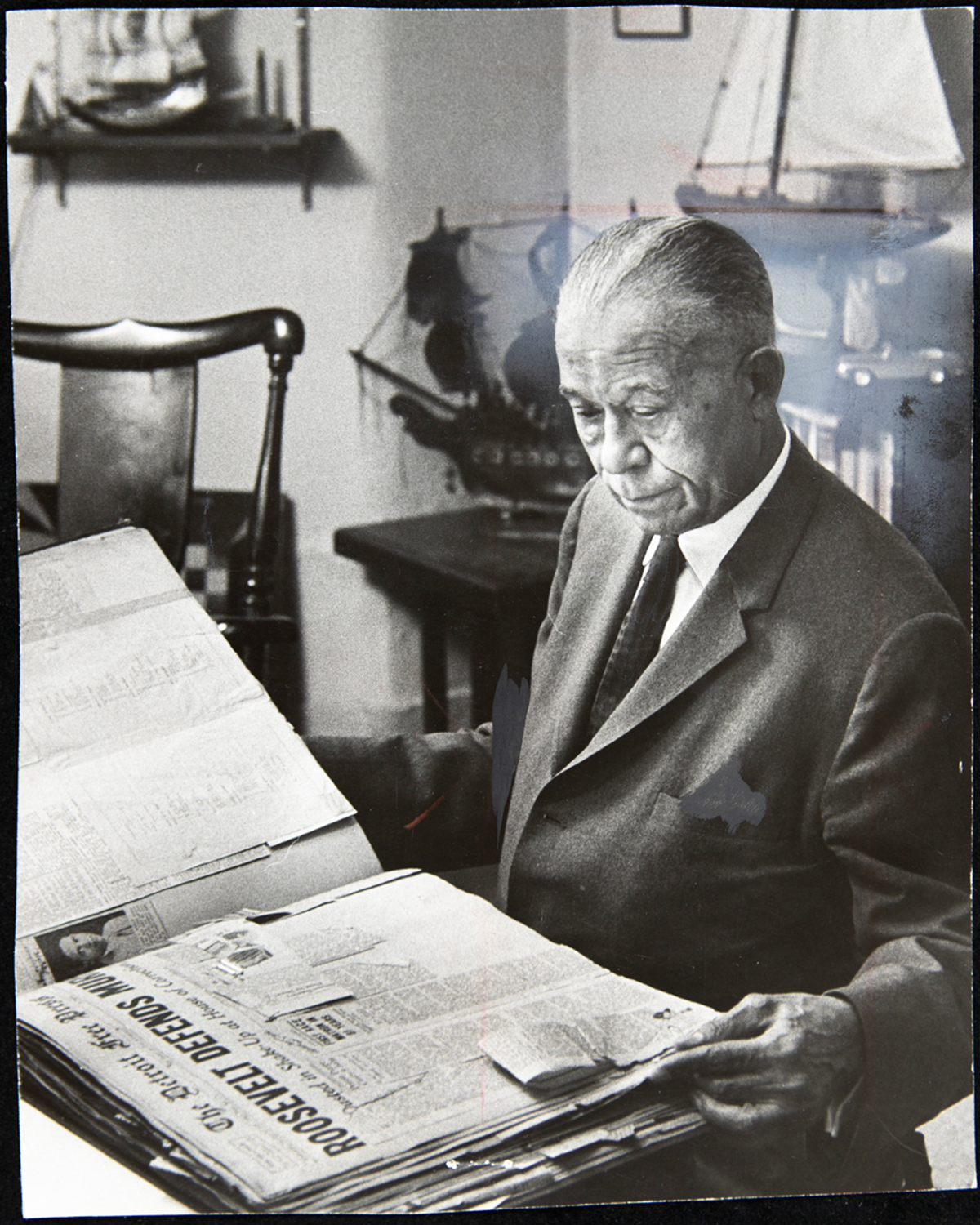
John C. Dancy, Executive Director of the Detroit Urban League, looking through a scrapbook, May 1966 / THF620105
Often blurring the lines between photo albums and journals, this craft typically takes the form of collecting paper items and selectively deciding what will be adhered into a blank book, where it will be placed, and why. Although it has taken different forms until reaching what we think of as a scrapbook today, this craft has been practiced for hundreds of years progressing hand in hand with the timeline of printing technology and availability of commercial goods.The widespread availability of scrapbook supplies from the 20th century and beyond proves that the books are still a popular means of expressing our personal wishes to capture parts of life.
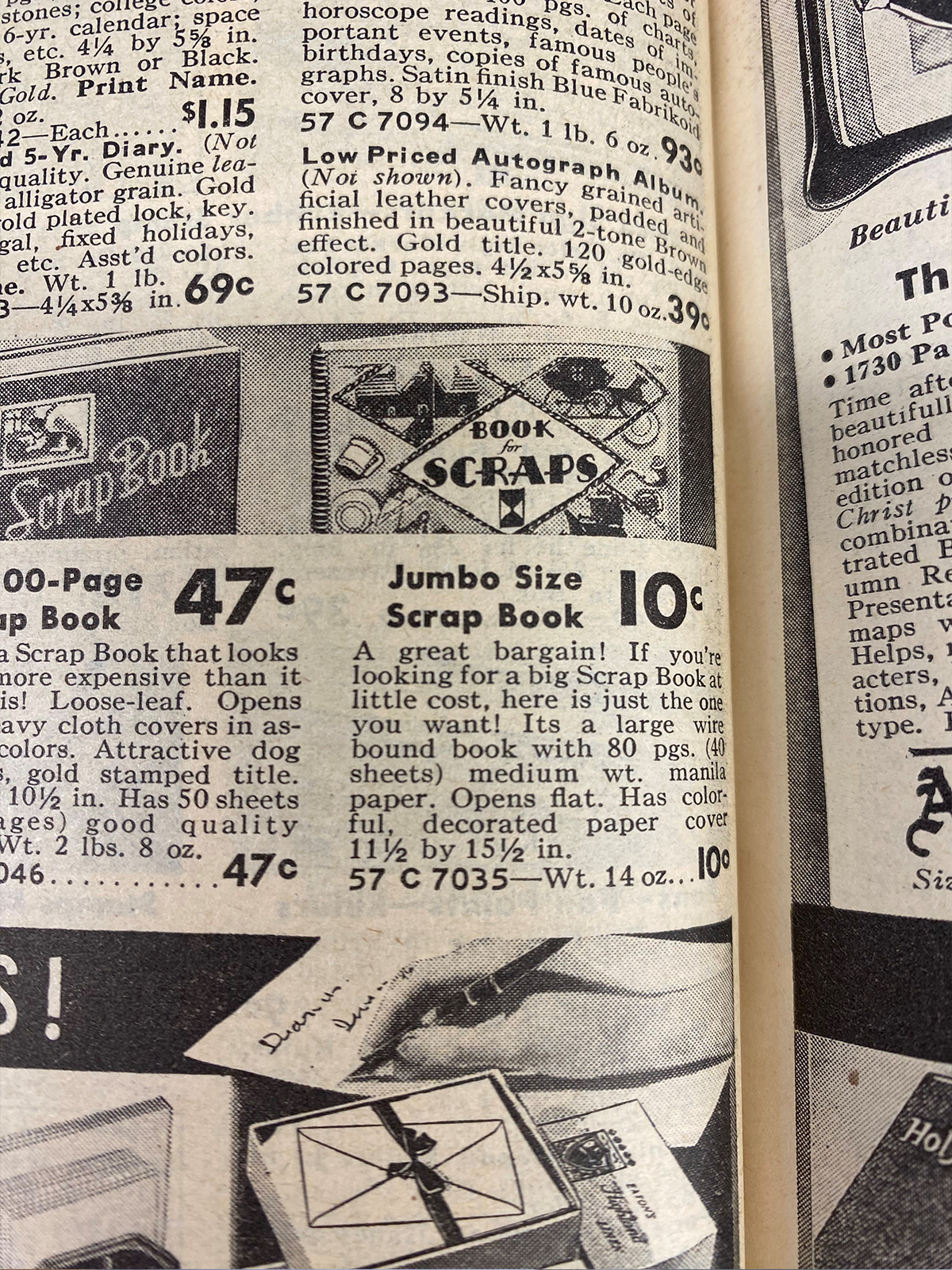
Advertisement for a ready-made blank scrapbook, Montgomery Ward 1938 catalog. P.B. 1938 / Image by Mollie Gordier
Just like their subject, scrapbook creators vary greatly as well. Housewives, children, businessmen, scientists, and so on have gotten into the “scrap book habit.” The Henry Ford is fortunate to have a wide-ranging collection of scrapbooks showcasing this diversity. Following are some examples.
Eva Tanguay, a vaudeville actress who took the country by storm, wished to document the newspaper clippings highlighting her performances at the American Music Hall in Chicago, Illinois, on May 18-31, 1913. As public coverage of her work was important to her, even the criticisms made their way into this memory capsule.
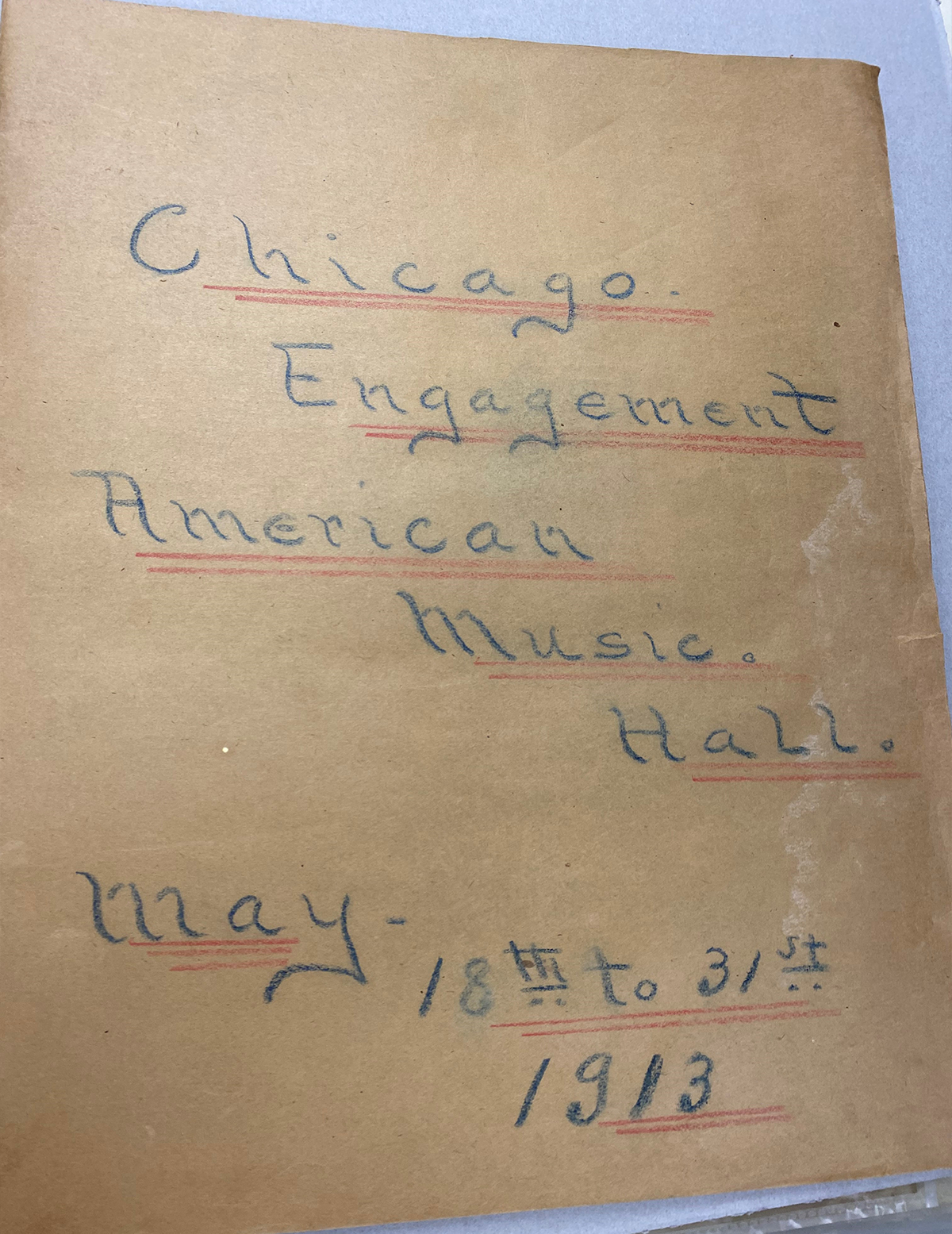
Cover of a scrapbook made by Eva Tanguay. 2005.100, Box 9 / Image by Mollie Gordier
World's Fairs were monumental events where people could experience new innovations, art, and the grandeur of architectural structures from around the world. For the 1939 New York World’s Fair, two Edison Institute teachers and their wives were sent along with students to the event for the summer. Hazel June Ebel, the wife of one teacher, compiled some memorable pictures of that experience.
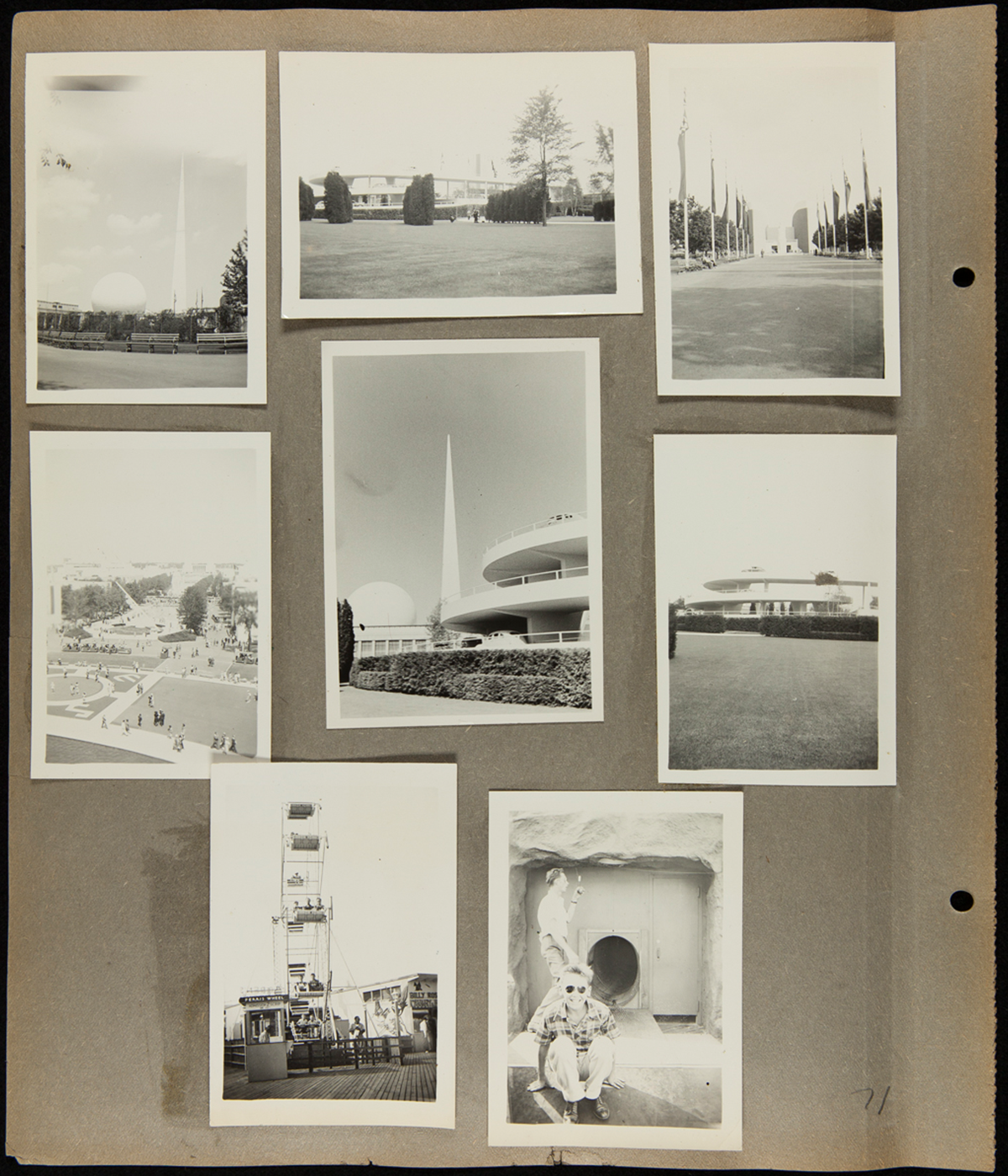
Page from a scrapbook compiled by Hazel June Ebel, 1939 / THF245988
Other scrapbooks aspired to capture momentous periods in time, such as the one created by Montgomery City Lines bus company supervisor, Charles “Homer” Cummings. Cummings went about compiling newspaper articles detailing the first few months of the Montgomery bus boycott that was sparked by Rosa Parks and her refusal to give up her bus seat in 1955.
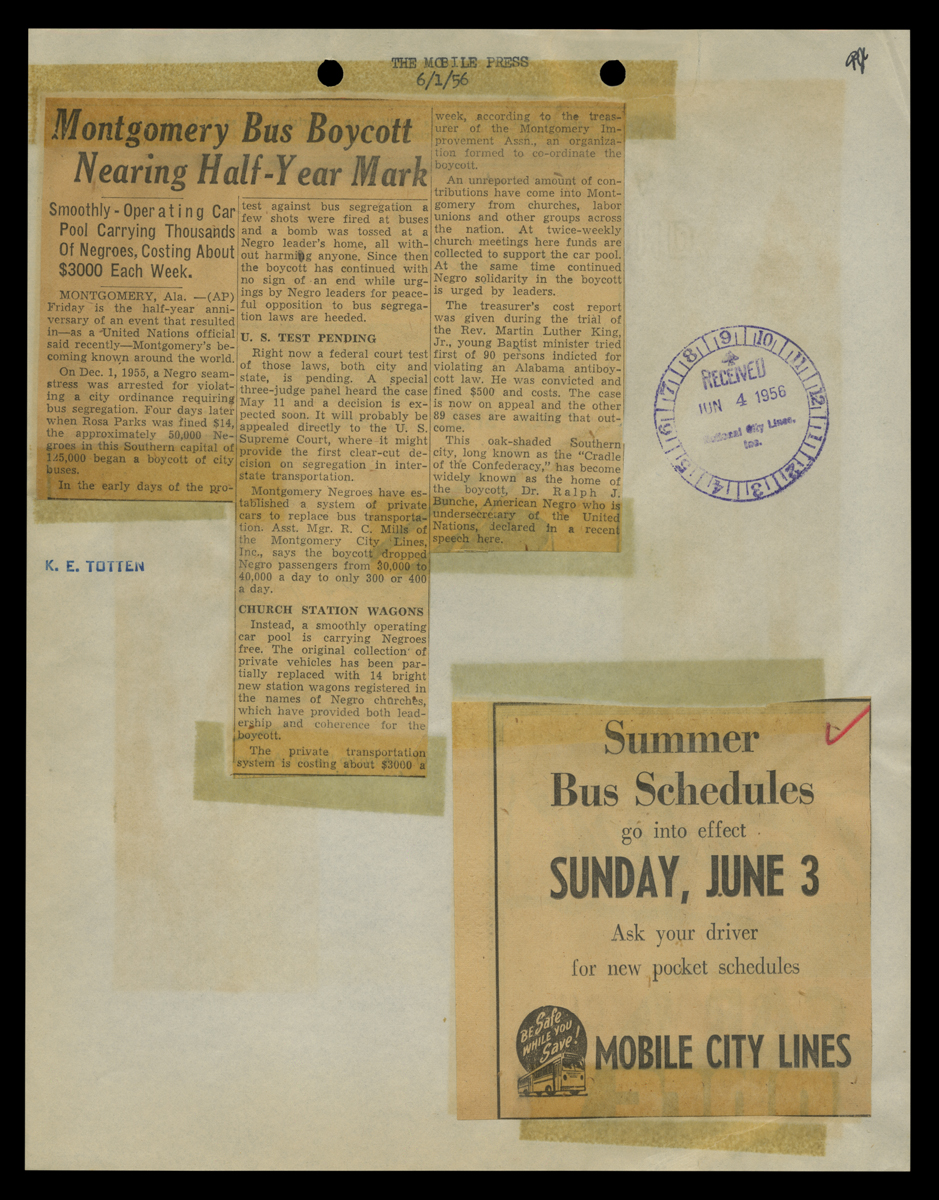
Page from the Montgomery Bus Boycott Scrapbook created by Charles H. (Homer) Cummings, November 1955-April 1957 / THF147439
Travel adventures were also exciting subjects to include in a scrapbook, particularly travel by automobile. This opportunity for rugged independence was gaining plenty of steam by the 1920s as more people purchased automobiles and roads became less like bumpy paths. This 1938 scrapbook showcases mementos documenting restaurants eaten at, hotels stayed in, routes taken, postcards collected, and movies seen.
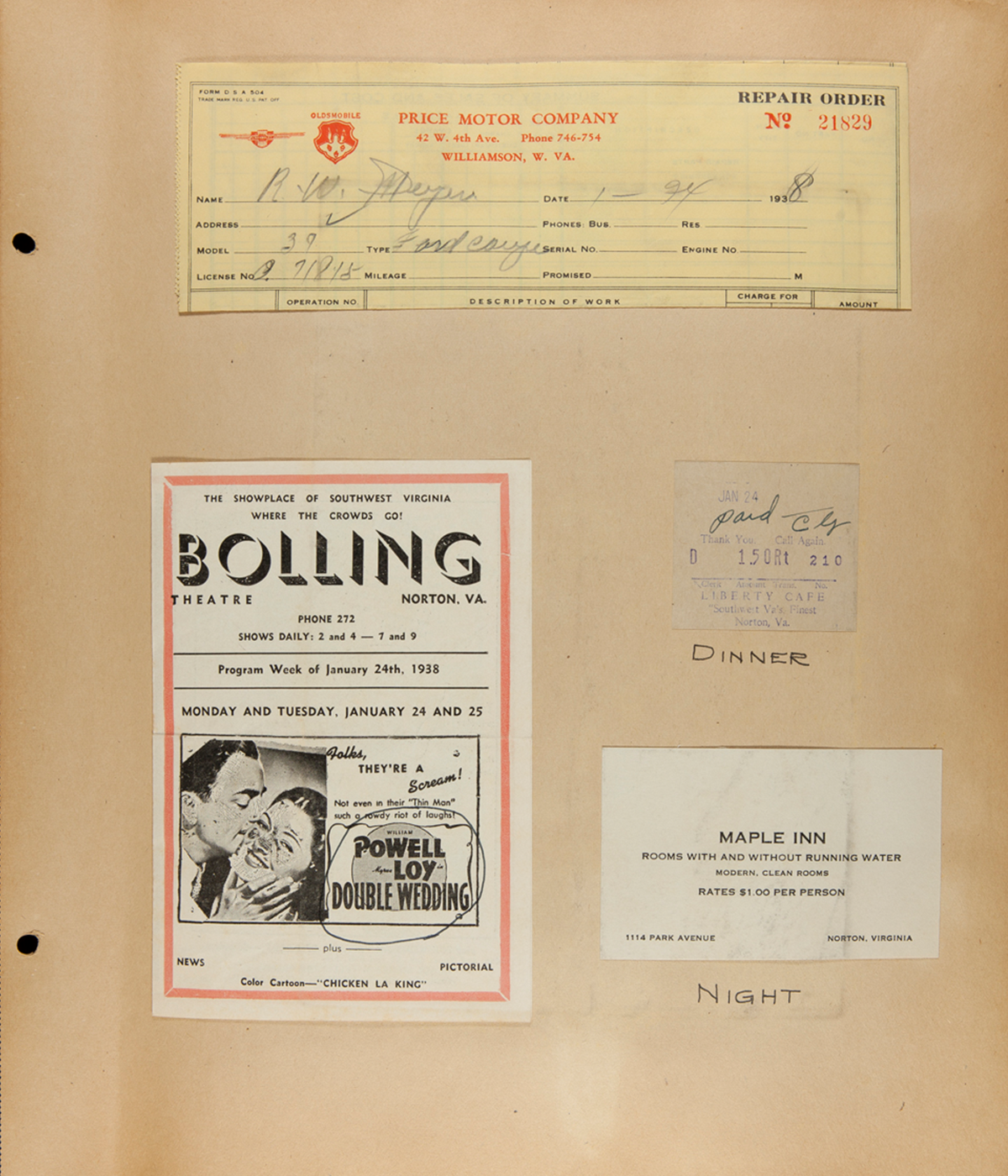
Page from a travel log of an automobile round trip from Saginaw, Michigan, to Miami, Florida, January 21-February 27, 1938 / THF240831
Scrapbooking is not only for the individual. Companies and organizations also partook in this craft, using it for product design, business documentation and recordkeeping. As is the case with the Heinz company, where they wanted to document some of the various food items they produced by creating a scrapbook with some of their early twentieth century product labels.
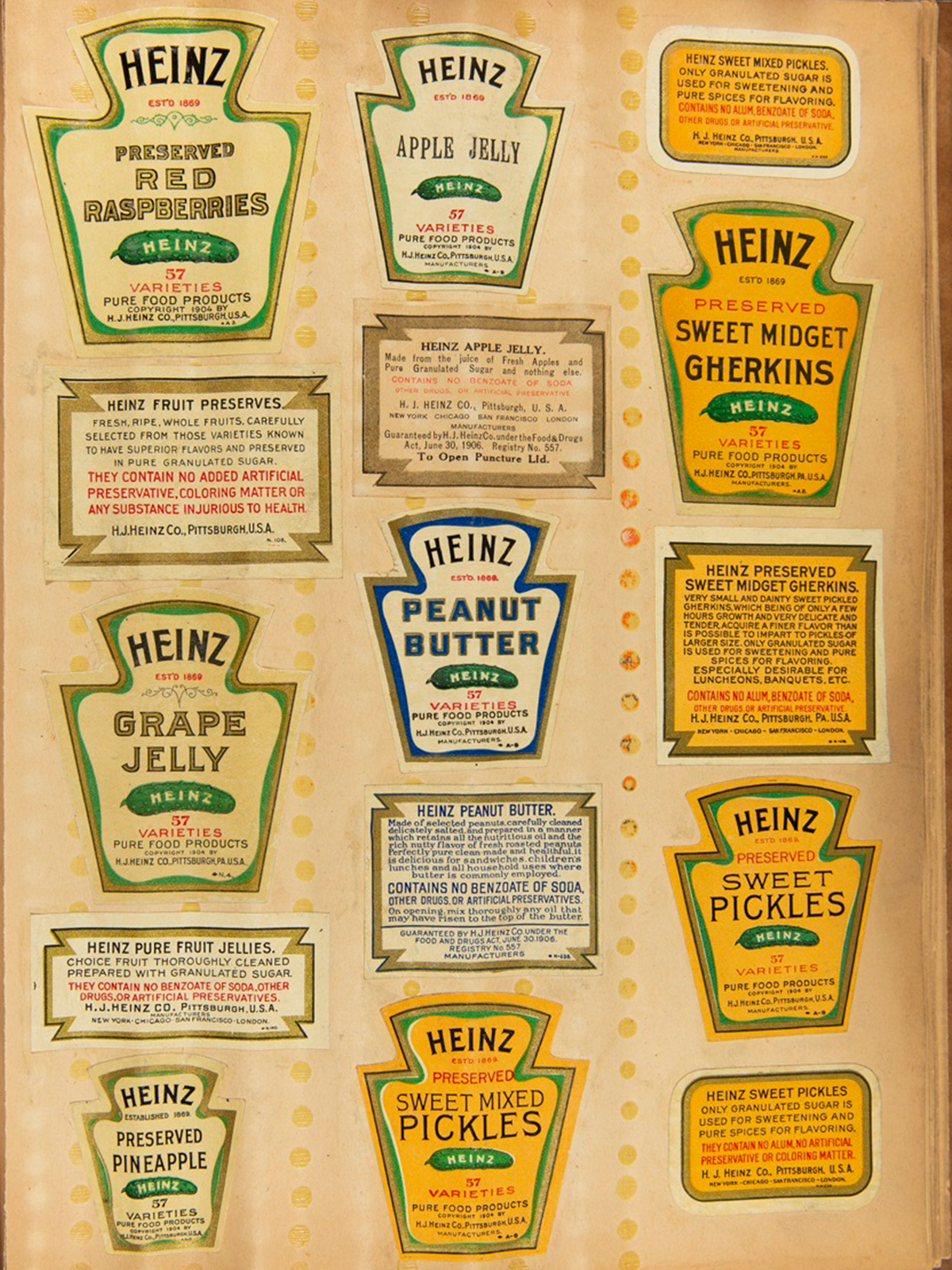
Page from a Heinz scrapbook containing Heinz product labels, 1900-1930 / THF293440
While many scrapbooks have an individualized touch or are completely improvisational, commercially constructed scrapbooks made with prompts ready to be filled out by the user were also available. Such as this 1999 “Nickellennium” scrapbook created for the television channel Nickelodeon to document the global lived experience of young people bringing in a new millennium. This book provided sections with questions or open-ended sentences for people to record what their lives were like at the moment while also envisioning what life would look like in the future. As an extra bonus, this scrapbook was produced in conjunction with a 5-hour world-broadcast documentary that aired for 24 hours on January 1, 2000 to document what young people all over the world had to say about what a Y2K era would bring.
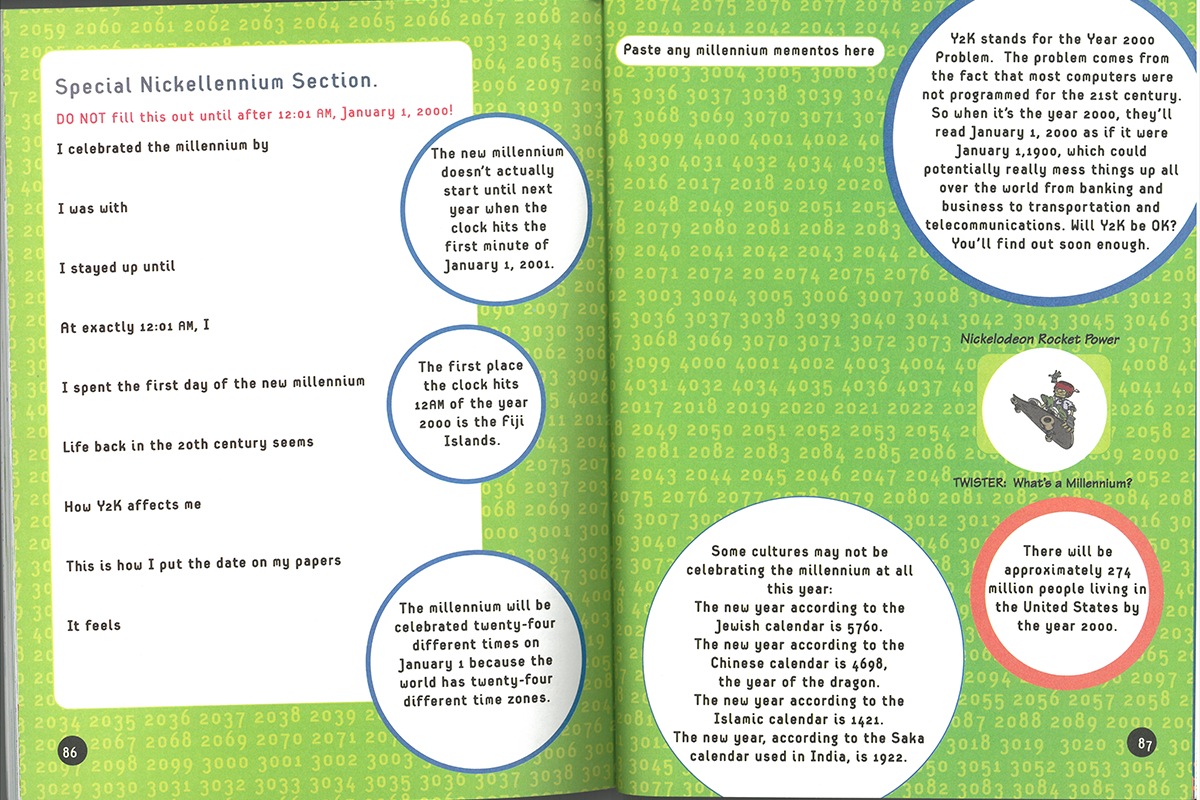
Pages from the Nickellennium scrapbook. 808.883 O32 1999. / Image by Mollie Gordier
With technological advances, scrapbook forms have transformed as well. One example is audio scrapbooks, such as this one containing various recordings of Ernie Harwell’s time as a baseball announcer from 1948 to 2002. Another example would be the entirely digital scrapbooks now available through online companies.
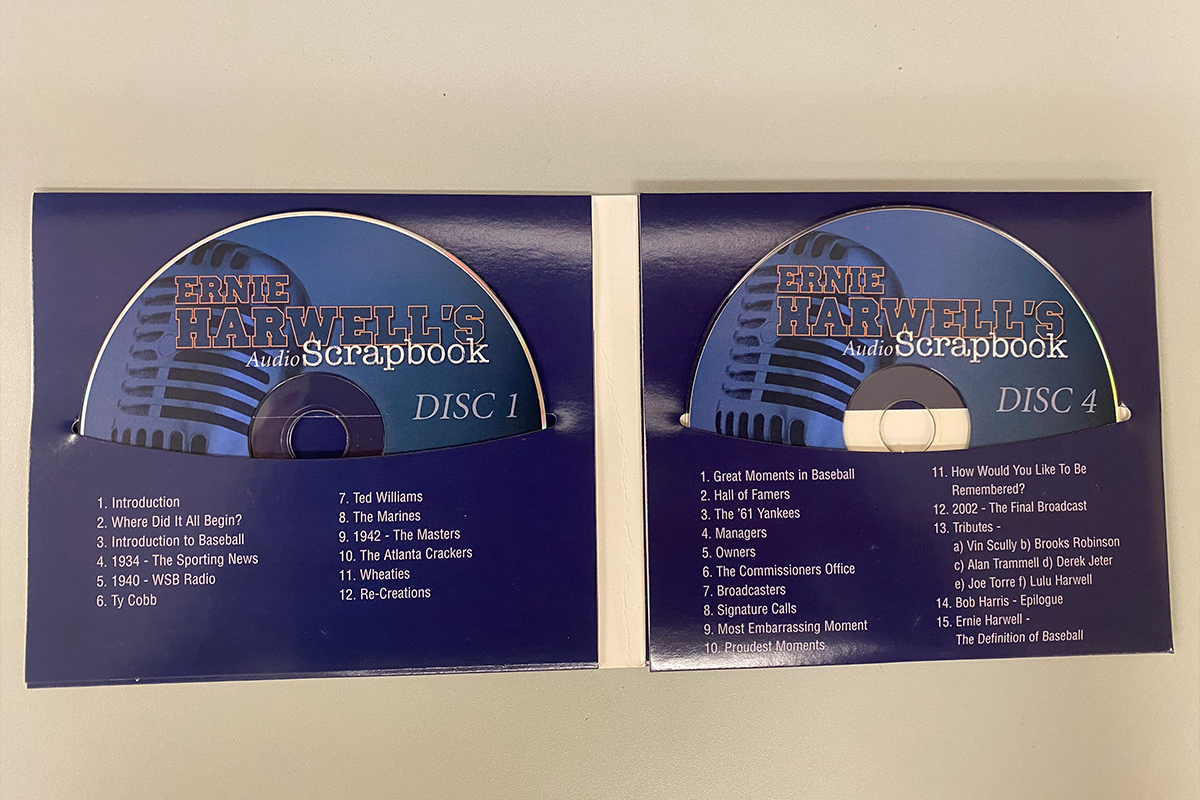
Inside case view of Ernie Harwell’s Audio Scrapbook. 796.357 H343 2006 CD. / Image by Mollie Gordier
While providing people a way to record physical materials and their significance, scrapbooking historically has also been a way to build communal experiences. There have been scrapbook contests, international school classroom scrapbook exchanges, scrapbooks made for organizations, and even stores dedicated to scrapbook supplies and learning.
Overall, whether crayons and construction paper were used or a store-bought book had ornate Victorian advertisements of cats dancing pasted throughout, scrapbooks have had a long and varied existence.
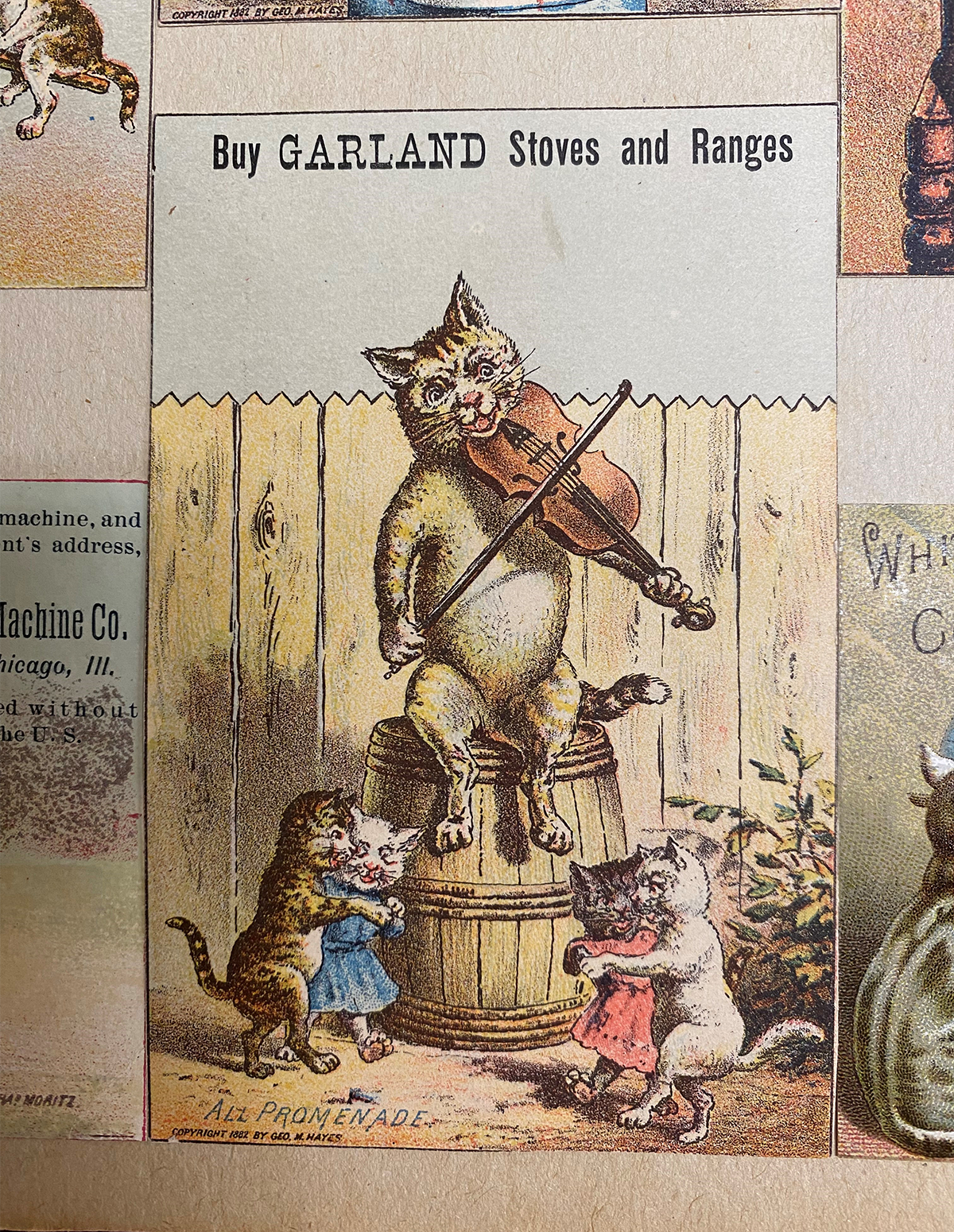
One of many decorative advertisements within a scrapbook created by Carree O’Keefe, circa 1895. 58.7.29. / Image by Mollie Gordier
For more information on the scrapbook material or any of our other collections, please reach out to the staff of the Benson Ford Research Center at research.center@thehenryford.org
Leo Goossen

Supercharger Assembly Drawing of Offenhauser Engine by Leo Goossen, April 21, 1934 / THF175170
Leo Goossen was an automotive draftsman, engineer, and one of the most influential engine designers in American auto racing. In a presentation from our monthly History Outside the Box series on Instagram earlier this year, Processing Archivist Janice Unger recognized Goossen’s 130th birthday with a quick biography and look at some of Goossen’s work from our collections. If you missed it on Insta, you can watch below.
California, 20th century, racing, race cars, Michigan, History Outside the Box, engines, engineering, drawings, cars, by Janice Unger, by Ellice Engdahl, archives
The Grand Army of the Republic and Memorial Day

Members of the Grand Army of the Republic (G.A.R.) Visiting Mount Vernon, September 21, 1892 / THF254036
The Grand Army of the Republic (G.A.R.) was a fraternal society founded in 1866 for Civil War veterans from the Union Army. Earlier this year, Collections Specialist Laura Myles shared some artifacts from our collections related to the G.A.R., and also explained their relationship with Memorial Day (originally called Decoration Day), as part of our History Outside the Box series on The Henry Ford’s Instagram channel. On the first Friday of every month, our collections experts share stories from our collection on Instagram—but if you missed this particular episode, you can watch it below.
Continue Reading
20th century, 19th century, veterans, holidays, History Outside the Box, Grand Army of the Republic, Civil War, by Laura Myles, by Ellice Engdahl
A Ride on the Magic Skyway at the New York World’s Fair

Loading Area for the Magic Skyway Ride at the Ford Pavilion, New York World's Fair, 1964-1965 / THF701306
On the first Friday of every month, our staff present interesting stories from our archives on The Henry Ford’s Instagram account as part of our “History Outside the Box” series. Earlier this year, Image Services Specialist Jim Orr took our followers on a virtual trip through time, back to the 1964–1965 New York World’s Fair. Particularly, Jim demonstrated what a ride on the Magic Skyway, an attraction designed by Walt Disney for Ford Motor Company’s Wonder Rotunda, would have looked and felt like. Take a quick trip to the Fair below!
New York, 1960s, 20th century, world's fairs, History Outside the Box, Ford Motor Company, Disney, cars, by Jim Orr, by Ellice Engdahl, archives
All Things Food: Cookbooks and Recipes

The Henry Ford’s first edition of Julia Child’s consummate classic Mastering the Art of French Cooking, published in 1964. / THF621455
On the first Friday of every month, the collections experts of The Henry Ford share items from our archives and library collections on our Instagram account as part of our History Outside the Box virtual program. Though the Instagram stories are only available for 24 hours, we share them afterwards as videos so you can catch up on what you missed. For March, Librarian Sarah Andrus shared a sampling of the wide array of cookbooks, recipe booklets, and handwritten recipes that have found a home in our collections. Check out her selections below.
Continue Reading
History Outside the Box, by Ellice Engdahl, by Sarah Andrus, recipes, books, food
NASA’s first attempt to land a spacecraft on the moon was the unmanned Ranger 3, launched on January 26, 1962.
THF141214
Ranger 3 carried a 25-inch “Lunar Facsimile Capsule,” developed by Ford Motor Company’s aerospace division, Aeronutronic, located in Newport Beach, California.
THF141217
Aeronutronic described the capsule as “a 300-pound ‘talking ball’ containing a seismometer to record moon quakes, temperature recording devices and other instruments.” The data these instruments collected about surface conditions on the moon would be important for planning later, manned missions.
Testing began in 1960. The capsule would need to withstand the extreme heat of lunar day and the extreme cold of lunar night. A special vacuum test chamber was used, which could be cooled by liquid nitrogen to minus 320 degrees Fahrenheit (minus 196 degrees Celsius).
THF141211
The small capsule was encased in an “Impact Limiter,” a larger ball made from carefully cut segments of balsa wood, which would protect the capsule and its delicate instruments from damage during its rough landing on the moon.
THF700675
The lunar landing sphere was mounted on a retrorocket that would decelerate the spacecraft to 80–100 mph (130–160 kph) as it impacted on the moon.
THF700681
The retrorocket was made from “Spiralloy,” a glass fiber composite. The retrorocket itself weighed only 15 pounds (7 kilograms).
THF700666
Unfortunately, Ranger 3 malfunctioned and flew past the moon on January 28, 1962.
THF700679, detail
Aeronutronic built two more lunar capsules, launched later in 1962 aboard Ranger 4 and Ranger 5. Ranger 4 was destroyed when it crashed into the far side of the moon on April 26, 1962. Ranger 5 missed the moon on October 21, 1962. It joined Ranger 3, trapped in orbit around the sun, where it remains to this day.
Following these failures, the Ranger spacecraft was completely redesigned for later missions in 1964–1965. These spacecraft would no longer carry a lunar landing sphere; instead, they would photograph the moon as they approached. Ranger 7, Ranger 8, and Ranger 9 successfully took over 17,000 thousand high-resolution photographs of the lunar surface.
Jim Orr is Image Services Specialist at The Henry Ford. This post is based on a July 2019 presentation of History Outside the Box.
California, 20th century, 1960s, space, History Outside the Box, Ford Motor Company, design, by Jim Orr
Lincoln’s Century with Ford Motor Company

1928 Lincoln Four-Passenger Coupe Advertising Proof, "Every Lincoln Body is a Custom Creation of Some Master Body Builder" / THF113063
One hundred years ago this month, Henry Ford purchased the Lincoln Motor Company from Henry Leland. The Henry Ford joined in the centennial celebration on our website, where we published a new Popular Research Topic outlining key Lincoln assets from our collections; on Facebook and Twitter, where we shared social posts featuring artifacts from our collections; and on Instagram, where Reference Archivist Kathy Makas shared a Lincoln-related story. Kathy’s story was part of our History Outside the Box monthly series on Instagram, featuring interesting or noteworthy items from our archives.
If you missed the live version of our Instagram story, you can check it out below to learn how Edsel Ford, as president of Lincoln, brought a design eye to the company and how design at Lincoln evolved. You’ll also discover a few of the famous celebrities who owned Lincolns, take a look at some Lincoln publications, and more.
Continue Reading
Ford family, History Outside the Box, Ford Motor Company, Edsel Ford, design, cars, by Kathy Makas, by Ellice Engdahl
Women in Agricultural Work and Research

Woman with Machine Spinning Soybean Fiber into Soylon Thread, March 1943 / THF272609
One of The Henry Ford’s main collecting areas is agriculture and the environment. Last fall, Processing Archivist Hilary Severyn shared highlights from our archives around women in agricultural work and research as part of our History Outside the Box program on Instagram. If you missed it, you can check out her selections, which range from women working on soybean research to the Women’s Land Army to Rachel Carson’s fight against pesticides, in the video below.
archives, History Outside the Box, Rachel Carson, soybeans, environmentalism, women's history, agriculture, by Ellice Engdahl, by Hilary Severyn
Lunch at Ford Motor Company

Women at Lunch Counter, Willow Run Bomber Plant, 1943 / THF114414
Lunch is a part of most people’s workday, but how much do you know about what lunch was like at Ford Motor Company in the first half of the 20th century? Reference Archivist Kathy Makas tackled this topic earlier this month as part of our monthly History Outside the Box series on Instagram. If you missed the Insta story, you can check out the replay below to find out more about the decline of the lunch bucket, the rise of the “sanitary box lunch,” employee cafeterias, and much more, all illustrated with photographs and documents from our archives.
Continue Reading
food, archives, Ford workers, Ford Motor Company, History Outside the Box, by Ellice Engdahl, by Kathy Makas
Celebrity Sightings from Our Archives

Edsel Ford, Charlie Chaplin, and Henry Ford Touring the Ford Motor Company Highland Park Plant, October 1923 / THF134659
Every month, staff from our library and archives select some interesting items from our collections to showcase on The Henry Ford’s Instagram account. In our every-first-Friday History Outside the Box offering, our collections experts share photographs, documents, and other artifacts around a given theme. Last summer, Reference Archivist Kathy Makas showcased some celebrity sightings from our archives—actors, actresses, and other luminaries visiting Ford Motor Company’s factories, World’s Fairs, and The Henry Ford’s own campus; showcasing their cars; and more. If you missed the Insta story, you can check out the presentation below.
Continue Reading
20th century, travel, Michigan, Dearborn, world's fairs, History Outside the Box, Henry Ford Museum, Greenfield Village, Ford Motor Company, cars, by Kathy Makas, by Ellice Engdahl, archives, actors and acting

